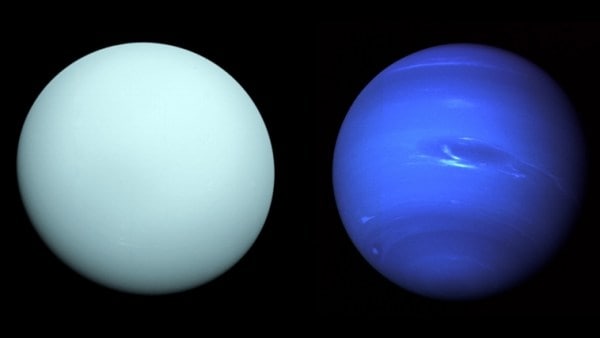The legacy of the Voyager mission
NASA detected a signal from its Voyager 2 spacecraft on August 1, after losing communication for over a week. Launched 46 years ago, Voyager 2 is currently in interstellar space. Along with Voyager 1, it has provided invaluable data and inspired future space missions.
 Artist concept showing NASA’s Voyager spacecraft against a backdrop of stars. (Credit: NASA/JPL-Caltech)
Artist concept showing NASA’s Voyager spacecraft against a backdrop of stars. (Credit: NASA/JPL-Caltech) More than a week after the National Aeronautics and Space Administration (NASA) lost communication with Earth’s longest-running space probe, Voyager 2, the space agency detected a “heartbeat” signal from the spacecraft on Tuesday (August 1).
Although too faint for extraction of data, the detected signal confirms that Voyager 2, which is about 19.9 billion kilometres away from Earth, is still operating.
On July 21, a faulty command sent to the probe caused its antenna to point 2 degrees away from Earth. “As a result, Voyager 2 is currently unable to receive commands or transmit data back to Earth,” a statement released by NASA on Wednesday said.
Launched around 46 years ago, Voyager 2 is the second spacecraft to enter interstellar space — the region that lies outside the impact of our Sun’s constant flow of material and magnetic field. The first was Voyager 1, sent to space about two weeks after Voyager 2 (yes, Voyager 1 was launched after Voyager 2).
Between them, the two probes have explored all the outer giant planets of our solar system and discovered over 40 moons and numerous rings. They have provided invaluable data on planetary astronomy, and inspired many future space missions.
Why were the Voyager spacecraft sent into space?
In 1972, NASA cancelled its plans of exploring the five outer planets (Mars, Jupiter, Saturn, Uranus and Neptune) with four highly complex spacecraft — the proposal, estimated to cost $ 1 billion, was scrapped due to budgetary constraints.
Instead, it proposed to send the Voyager probes, initially slated to explore only Jupiter and Saturn. In 1974, however, it was decided that if one spacecraft completes the mission, the other one would be redirected towards Uranus and then Neptune.
Interestingly, the spacecraft were scheduled for a take-off towards the end of the 1970s for a reason. According to a report by Scientific American, NASA chose the particular launch window to take advantage of a rare alignment of Jupiter, Saturn, Uranus and Neptune that occurs once every 175 years.
 An illustration of the trajectories of Voyager 1 and Voyager 2. (Image credit: NASA/JPL-Caltech)
An illustration of the trajectories of Voyager 1 and Voyager 2. (Image credit: NASA/JPL-Caltech)
“The alignment allowed the spacecraft to harness the gravity of each planet and swing from one to the next using relatively minimal amounts of fuel. NASA first demonstrated the technique with its Mariner 10 mission to Venus and Mercury from 1973 to 1975,” the report said.
Voyager 2 was launched on August 20, 1977, two weeks before the September 5 Voyager 1 takeoff. This reversal of order took place as the two spacecraft were put on different trajectories — Voyager 1 was set on a path to reach Jupiter and Saturn, ahead of Voyager 2.
What are the features of the Voyager spacecraft?
Voyager 1 and Voyager 2 are identical spacecraft. Each of them is equipped with instruments to carry out 10 different experiments. The instruments include television cameras — to take images of planets and other celestial bodies — infrared and ultraviolet sensors, magnetometers, plasma detectors, and cosmic-ray and charged-particle sensors.
 The Voyager 2 spacecraft made its closest approach to Jupiter on July 9, 1979. (Wikimedia Commons)
The Voyager 2 spacecraft made its closest approach to Jupiter on July 9, 1979. (Wikimedia Commons)
Both spacecraft feature a large antenna, 3.7 metres in diameter, which is used to receive commands from Earth and radio their findings back to the planet. As their mission involved going far away from the Sun, they aren’t powered by solar power, like other spacecraft are. “Instead, Voyager relies on a small nuclear power plant, drawing hundreds of watts from the radioactive decay of a pellet of plutonium,” writes American astronomer Carl Sagan, who played a leading role in the Voyager mission, in his book Cosmos.
Notably, each Voyager spacecraft is adorned with a golden phonograph record — a 12-inch disc, intended to be a sort of time capsule from Earth to any extraterrestrial life that might intercept the probes in the distant future.
 This gold aluminum cover was designed to protect the Voyager 1 and 2 “Sounds of Earth” gold-plated records from micrometeorite bombardment. (Credits: NASA)
This gold aluminum cover was designed to protect the Voyager 1 and 2 “Sounds of Earth” gold-plated records from micrometeorite bombardment. (Credits: NASA)
“The covers of the records have several images inscribed, including visual instructions on how to play them, a map of our solar system’s location with respect to a set of 14 pulsars, and a drawing of a hydrogen atom. They are plated with uranium – its rate of decay will allow any future discoverers of either of the records to calculate when they were created,” a report by The Planetary Society said.
Moreover, the records’ content, selected for NASA by a committee chaired by Carl Sagan, includes 115 analogue-encoded images, a variety of natural sounds, such as those made by surf, wind and thunder, birds, whales, and other animals, musical selections from different cultures and eras, and spoken greetings from Earth-people in 55 languages, and printed messages from then US President Jimmy Carter.
What are the most notable achievements of the Voyager spacecraft?
Fifteen months after its launch, Voyager 1 reached its first target planet, Jupiter, on March 5, 1979, and was soon followed by Voyager 2, which arrived there on July 9. The most interesting discoveries made by Voyager 1 included the finding that Io, one of Jupiter’s moons, was geologically active. The spacecraft noted the presence of at least eight active volcanoes “spewing material into space, making it one of the most (if not the most) geologically active planetary bodies in the solar system,” another report by NASA said.
 Jupiter as seen by Voyager 1. (Wikimedia Commons)
Jupiter as seen by Voyager 1. (Wikimedia Commons)
Moreover, Voyager 1 and Voyager 2 discovered three new moons of Jupiter: Thebe, Metis and Adrastea.
Following the Jupiter encounter, the spacecraft, one by one, moved towards Saturn. While passing by the planet’s moon Titan, Voyager 1 discovered that it wasn’t the biggest moon of our solar system, contrary to what scientists of the time believed — “the diameter of the solid centre was found (through radio signals) to be smaller than Jupiter’s Ganymede”, a BBC report noted. The spacecraft also noted that Titan’s atmosphere was composed of 90 per cent nitrogen, and it likely had clouds and rain of methane.
 Saturn as seen by Voyager 1. (NASA)
Saturn as seen by Voyager 1. (NASA)
After the Saturn expedition, as Voyager 1 headed on a trajectory to escape the solar system, Voyager 2 was redirected towards Uranus — both probes had fulfilled their primary mission goals but scientists kept them operational for further exploration.
Voyager 2 arrived at Uranus in 1986, becoming the first human-made object to fly past the aquamarine planet. The spacecraft took stunning photographs and confirmed that the main constituents of Uranus are hydrogen and helium. It also discovered 10 new moons and two new rings in addition to the previously-known nine rings, among other significant findings.
 Uranus and Neptune as seen by Voyager 2. This pic pieces together two separate images of Uranus and Neptune clicked by Voyager. (Credit: NASA/JPL-Caltech)
Uranus and Neptune as seen by Voyager 2. This pic pieces together two separate images of Uranus and Neptune clicked by Voyager. (Credit: NASA/JPL-Caltech)
Then, the probe went to Neptune. Becoming the first human-made object to fly by the planet in 1989, Voyager 2 made some more notable discoveries there. Apart from finding new moons and rings, it discovered that Neptune is more active than previously thought — winds on the planet blow at the speed of 1,100 kph. The spacecraft also observed the Great Dark Spot, which was essentially a huge spinning storm in the southern atmosphere of Neptune and it was about the size of the entire Earth.
After the Neptune encounter, Voyager 2, like Voyager 1, was put on the path to head out of the solar system. While Voyager 1 officially entered interstellar space in August 2012, Voyager 2 made its entry in November 2018.
“These exits were instrumental in enabling astronomers to determine where exactly the edge of interstellar space is, something that’s difficult to measure from within the solar system. They showed that interstellar space begins just over 18 billion kilometres from the sun,” The Planetary Society report said.
Although most of the instruments on the spacecraft aren’t operational, Voyager probes have been transmitting data back to Earth over the years — it is only after the recent glitch that Voyager 2 has stopped sending back the data but scientists hope to regain full communication with the spacecraft soon. But eventually, there will not be enough electricity to power both probes. After that, Voyager 1 and Voyager 2 will silently continue their journey among the stars.
- 01
- 02
- 03
- 04
- 05





































